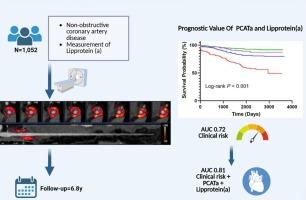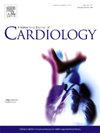CCTA-quantified pericornary inflammation and lipoprotein (a): Combined predictive value in non-obstructive CAD
IF 3.2
2区 医学
Q2 CARDIAC & CARDIOVASCULAR SYSTEMS
引用次数: 0
Abstract
Objective
This study aimed to enhance major adverse cardiovascular events (MACEs) prediction by pericoronary adipose tissue attenuation (PCATa) in non-obstructive coronary artery disease (CAD) patients when combined with lipoprotein (a) (Lp(a)).
Methods
A total of 1052 patients with non-obstructive CAD were included. Detailed clinical data and CCTA features were analyzed. The MACEs in this study was defined as a composite of non-fatal myocardial infarction, new-onset heart failure requiring hospitalization, stroke, all-cause mortality, and coronary revascularization.
Results
During a median follow-up of 6.8 (5.6–7.9) years, 183 (17.4 %) patients suffered from MACEs. Patients experiencing MACEs demonstrated elevated Lp(a) levels and PCATa values (26.20 (17.63–45.08) vs. 12.00 (4.58–26.00), P < 0.001; −72.6 ± 8.4 HU vs. -79.7 ± 9.5 HU, P < 0.001). Lp(a) was associated with PCATa (P < 0.001). Elevated PCATa was associated with quantitatively greater atherosclerotic burden (P < 0.001). Multivariate Cox regression showed that age (HR = 1.03, P = 0.001), hypertension (HR = 1.39, P = 0.036), triglyceride (HR = 1.23, P = 0.003), high-risk plaque (HR = 2.30, P < 0.001), LAPV% (HR = 2.66, P < 0.001), Lp(a) (HR = 1.26, P < 0.001) and PCATa (HR = 1.44, P < 0.001) were independently associated with increased risk of MACEs. Kaplan-Meier analysis demonstrated that patients with Lp(a) ≥30 mg/dL and PCATa > − 78 HU had the highest incidence of MACEs (P < 0.001). Additionally, combination Lp(a) and PCATa showed the highest AUC (P < 0.001).
Conclusion
Incorporating Lp(a) and PCATa significantly improves MACEs prediction in non-obstructive CAD patients, where higher Lp(a) levels are linked to elevated PCATa.

ccta量化的冠状动脉周围炎症和脂蛋白(a):非阻塞性CAD的联合预测价值。
目的:本研究旨在通过冠状动脉周围脂肪组织衰减(PCATa)联合脂蛋白(Lp(a))增强对非阻塞性冠状动脉疾病(CAD)患者主要不良心血管事件(mace)的预测。方法:共纳入1052例非阻塞性CAD患者。详细分析临床资料及CCTA特征。本研究中的mace定义为非致死性心肌梗死、需要住院治疗的新发心力衰竭、中风、全因死亡率和冠状动脉血运重建术的组合。结果:在中位随访6.8(5.6-7.9)年期间,183例(17.4 %)患者发生mace。经历mace的患者表现出Lp(a)水平和PCATa值升高(26.20 (17.63-45.08)vs. 12.00 (4.58-26.00), P - 78 HU的mace发生率最高(P )结论:合并Lp(a)和PCATa可显著改善非阻塞性CAD患者的mace预测,其中较高的Lp(a)水平与PCATa升高有关。
本文章由计算机程序翻译,如有差异,请以英文原文为准。
求助全文
约1分钟内获得全文
求助全文
来源期刊

International journal of cardiology
医学-心血管系统
CiteScore
6.80
自引率
5.70%
发文量
758
审稿时长
44 days
期刊介绍:
The International Journal of Cardiology is devoted to cardiology in the broadest sense. Both basic research and clinical papers can be submitted. The journal serves the interest of both practicing clinicians and researchers.
In addition to original papers, we are launching a range of new manuscript types, including Consensus and Position Papers, Systematic Reviews, Meta-analyses, and Short communications. Case reports are no longer acceptable. Controversial techniques, issues on health policy and social medicine are discussed and serve as useful tools for encouraging debate.
 求助内容:
求助内容: 应助结果提醒方式:
应助结果提醒方式:


